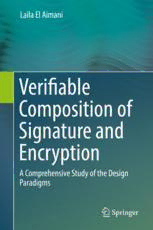Table Of ContentLaila El Aimani
Verifi able
Composition of
Signature and
Encryption
A Comprehensive Study of the Design
Paradigms
Verifiable Composition of Signature and Encryption
Laila El Aimani
Verifiable Composition of
Signature and Encryption
A Comprehensive Study of the Design
Paradigms
123
LailaElAimani
ÉcoleNationaledesSciencesAppliquéesdeSafi
CadiAyyadUniversity
Safi,Morocco
ISBN978-3-319-68111-5 ISBN978-3-319-68112-2 (eBook)
https://doi.org/10.1007/978-3-319-68112-2
LibraryofCongressControlNumber:2017953945
©SpringerInternationalPublishingAG2017
Thisworkissubjecttocopyright.AllrightsarereservedbythePublisher,whetherthewholeorpartof
thematerialisconcerned,specificallytherightsoftranslation,reprinting,reuseofillustrations,recitation,
broadcasting,reproductiononmicrofilmsorinanyotherphysicalway,andtransmissionorinformation
storageandretrieval,electronicadaptation,computersoftware,orbysimilarordissimilarmethodology
nowknownorhereafterdeveloped.
Theuseofgeneraldescriptivenames,registerednames,trademarks,servicemarks,etc.inthispublication
doesnotimply,evenintheabsenceofaspecificstatement,thatsuchnamesareexemptfromtherelevant
protectivelawsandregulationsandthereforefreeforgeneraluse.
Thepublisher,theauthorsandtheeditorsaresafetoassumethattheadviceandinformationinthisbook
arebelievedtobetrueandaccurateatthedateofpublication.Neitherthepublishernortheauthorsor
theeditorsgiveawarranty,expressorimplied,withrespecttothematerialcontainedhereinorforany
errorsoromissionsthatmayhavebeenmade.Thepublisherremainsneutralwithregardtojurisdictional
claimsinpublishedmapsandinstitutionalaffiliations.
Printedonacid-freepaper
ThisSpringerimprintispublishedbySpringerNature
TheregisteredcompanyisSpringerInternationalPublishingAG
Theregisteredcompanyaddressis:Gewerbestrasse11,6330Cham,Switzerland
Tomyfamily
Preface
Scope Cryptographicmechanismsthatrequirethefunctionalitiesofbothsignature
andencryptionarebecomingnowadaysincreasinglyimportant.
Consider for example the case of interorganizational electronic documents;
digital signatures on these documents are indispensable to resolve disputes as
they ensure integrity and authenticity of the underlying messages; however, self-
authentication of the signatures will make the messages vulnerable to industrial
spy or extortionist. Therefore, it is imperative to control the signature verification
by applying for instance an encryption layer that obscures the signatures and
makes them opaque. Also, a secure email application requires signature and
encryption simultaneously to guarantee confidentiality, integrity, and authenticity
oftheexchangedemails.
Verifiability is an important feature in those mechanisms. In fact, it can be
applicable in filtering out spams in an email application; the spam filter should be
abletocheckthevalidityoftheencryptedemailwithoutdecryptingit.Besides,the
receiver that decrypts the email might be compelled, for instance to resolve later
disputes,toprovethatthesenderisindeedtheauthorofagivenmessage.Likewise,
theauthoroftheopaquesignaturemightneedtoproveitsvaliditywithrespecttoa
givenmessage,ortodelegatethistasktoathirdparty.
This Book’s Objectives This book attempts to give a thorough treatment of the
celebratedcompositionsofsignatureandencryptionthatallowforgoodverifiability,
i.e., possibility to efficiently prove properties about the encrypted data. The study
isprovidedinthecontextoftwocryptographicprimitives:(1)designatedconfirmer
signatures, an opaque signature which was introduced to control the proliferation
of certified copies of documents, and (2) signcryption, a primitive that offers
simultaneouslyandefficientlyprivacyandauthenticity.
The choice of the case-study primitives is motivated by the need to have a
representativeofprimitivesthatrequirebothconfidentialityandauthenticityofthe
data, and a representative of opaque signatures which obfuscate the authenticity
of the signed data while disclosing the latter. The hope is to be able to extend
vii
viii Preface
thepresent studytocover theplethora ofcryptographic mechanisms thatuseboth
signatureandencryption,andneedgoodverifiability.
Insteadofgivingacompendiumofresultsaboutthestudiedprimitives,Itakean
instructive approach to first analyze and explain the shortcomings of the existing
paradigms used to build the primitives, then proceed to the exposition of the
efficient variants while giving the reader understanding and appreciation of the
design methodology. Moreover, I endeavor to gradually supplement and reinforce
thesecuritymodelinwhichtheprimitivesarebeinganalyzed;thegoalistoprovide
flexibledesignoptionsaccordingtotherequiredsecurity.
Audience Thebookisaimedatthefollowingaudiences.
• Researchers in cryptology/privacy. These readers will find a single-point refer-
ence book which gives a sound and rigorous treatment of the existing compo-
sitions of signature and encryption found in a great number of cryptographic
and privacy-preserving mechanisms. Such a book can help this audience enter
quickly into and master this vast area of study. It also presents an important
literature survey material which can help them find further literature and
consequentlyshapetheirownresearchtopics.
• Graduate and PhD students beginning their research in cryptology and infor-
mation security. These readers will find in this monograph a suitable cut-down
set of many properly interwoven topics that form the basic pillars of modern
cryptography;tonamebutafew:digitalsignatures,(tag-based)encryption,(non)
interactiveproofs,zero-knowledge,(meta)reductions.
• Security engineers in high-tech companies responsible for the design and
developmentofcryptographicandprivacy-preservingsolutions.Infact,thebook
providesdesignprinciplesandguidelinesforcertaincryptographicmechanisms
in a pedagogical manner that allows to easily extend the study to further
mechanisms.Itconstitutesthenasuitableself-teachingtextforthispopulationin
theareasubjecttothestudy.
Content The book is organized into four parts. There is a tight continuity
from one part to the next to ensure a quick comprehension of the material.
Thus, Part I (Chaps.1 and 2) gives the necessary background in the theoretical
foundations of modern cryptography, including the definition of the case-study
primitives. Part II (Chaps.3 and 4) and Part III (Chaps.5 and 6) cover the
existing compositions of signature and encryption, namely Sign_then_Encrypt
(StE)andCommit_then_Encrypt_and_Sign(CtEaS)includingthespecialinstance
Encrypt_then_Sign (EtS). Both parts start with a close scrutiny of the mentioned
paradigmsbeforeputtingforwardthemoreefficientnewanalogs.PartIV(Chaps.7–
9)buildsfromtheworkdevelopedinthepreviouspartstopropoundnewparadigms
that respond to stronger security requirements without compromising efficiency.
Finally,wesummarizeinChap.10theconclusionstobedrawnfromourstudy.
Preface ix
Acknowledgments
IdevelopedmostresultspresentedinthisbookduringmyPhDandmypostdocat
the University of Bonn and Technicolor respectively. It is a pleasure to thank my
PhD supervisor Joachim von zur Gathen for his invaluable support and feedback
duringmystudies.AspecialnoteofthanksgotoDamienVergnaudformakingme
discovercryptographicprotocolsandforhissubstantialhelpduringtheearlystages
of my PhD. I would also like to express my deep gratitude to my postdoc mentor
MarcJoyeforhisgeneroussupportandcountlesssuggestionstoimprovemyresults.
MyPhDreviewerKennyPatersondeservesspecialmentionforreadingmythesis,
apreliminaryversionofthepresentedresults,inexcruciatingdetailandgivingme
constructive comments thatgreatlyimproved theresultsandinspiredmetoderive
new ones. I benefited from collaboration/correspondence with many researchers;
I wish to thank all my colleagues and coauthors for precious discussions which
wereagreatsourceofinspirationwhilewritingthistext.IamalsogratefultoJorge
NakaharaJr.forencouragingmetoturnmyresultsintoabookandforhisexcellent
cooperation and availability throughout the edition process. Last but not least, I
wishtoexpressmyprofoundgratitudetomyfamilyforconstantunderstandingand
endless support over the years. I am also indebted to my institute ESTS at Cadi
Ayyad University for providing a nice working environment for completing this
work.
Safi,Morocco LailaElAimani
July2017
Contents
PartI Background
1 Preliminaries................................................................ 3
1.1 CryptographicPrimitives.............................................. 3
1.1.1 DigitalSignatures ............................................. 3
1.1.2 Public-KeyEncryption(PKE)................................ 6
1.1.3 Key/DataEncapsulationMechanisms........................ 10
1.1.4 Tag-BasedEncryption(TBE)................................. 12
1.1.5 CommitmentSchemes ........................................ 14
1.2 Number-TheoreticProblems.......................................... 16
1.2.1 Factoring-RelatedProblems .................................. 16
1.2.2 Discrete-Log-RelatedProblems .............................. 17
1.3 ReductionistSecurity.................................................. 20
1.3.1 CryptographicReductions .................................... 20
1.3.2 ProofModels .................................................. 22
1.3.3 Meta-reductionsinCryptography ............................ 23
1.4 CryptographicProofSystems......................................... 24
1.4.1 InteractiveProofs.............................................. 24
1.4.2 Zero-Knowledge(ZK) ........................................ 25
1.4.3 †Protocols.................................................... 27
1.4.4 Non-interactiveProofs ........................................ 28
References.................................................................... 29
2 Case-StudyPrimitives...................................................... 31
2.1 ConvertibleDesignated-ConfirmerSignatures(CDCS) ............. 31
2.1.1 Motivation ..................................................... 31
2.1.2 Syntax.......................................................... 32
2.1.3 SecurityModelforCDCS .................................... 33
xi
xii Contents
2.2 Signcryption ........................................................... 39
2.2.1 MotivationandChallenges.................................... 39
2.2.2 Syntax.......................................................... 41
2.2.3 SecurityModel ................................................ 42
References.................................................................... 43
PartII The“Sign_then_Encrypt”(StE)Paradigm
3 AnalysisofStE.............................................................. 49
3.1 StEforConfirmerSignatures ......................................... 49
3.1.1 TheStEParadigm............................................. 49
3.1.2 OtherVariants ................................................. 50
3.2 TheExactUnforgeabilityofStEConstructions...................... 52
3.2.1 RoadmapfortheRestoftheChapter......................... 53
3.3 ABreachinInvisibilitywithHomomorphicEncryption............ 53
3.4 ImpossibilityResultsforKey-PreservingReductions ............... 54
3.4.1 InsufficiencyofOW-CCASecureEncryption............... 55
3.4.2 InsufficiencyofNM-CPASecureEncryption................ 56
3.4.3 PuttingAllTogether........................................... 56
3.5 ExtensiontoArbitraryReductions.................................... 57
3.6 AnalysisofDamgård-Pedersen’sUndeniableSignatures ........... 60
3.7 SufficiencyofIND-PCASecureEncryption......................... 62
References.................................................................... 64
4 AnEfficientVariantofStE................................................ 67
4.1 TheNewStE........................................................... 67
4.1.1 Construction................................................... 67
4.1.2 SecurityAnalysis.............................................. 69
4.2 PracticalRealizations.................................................. 72
4.2.1 TheClassSofSignatures..................................... 73
4.2.2 TheClassEofEncryptionSchemes ......................... 74
4.2.3 Confirmation/DenialProtocols ............................... 76
4.3 FurtherEnhancements................................................. 78
4.3.1 ReducingtheSoundnessError................................ 78
4.3.2 OnlineNon-transferability.................................... 79
4.4 PerformanceoftheNewStE.......................................... 80
References.................................................................... 81
PartIII The “Commit_then_Encrypt_and_Sign” (CtEaS)
Paradigm
5 AnalysisofCtEaS........................................................... 85
5.1 CtEaSforConfirmerSignatures ...................................... 85
5.2 TheExactInvisibilityofCtEaS....................................... 87
5.2.1 ImpossibilityResults.......................................... 87
5.2.2 SufficiencyofIND-PCASecureEncryption................. 89
References.................................................................... 91

